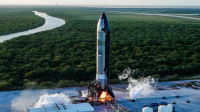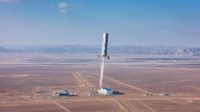Amazon‘s ambitious Project Kuiper initiative, aimed at delivering broadband services via a constellation of satellites, faces a revised timeline with initial services now expected in 2025. The company disclosed this update on June 27, citing logistical adjustments and production milestones.
Initially planned for deployment in the first half of 2024 with beta trials involving partners like Verizon, Amazon now anticipates sending its first batch of production satellites to Florida this summer. These satellites will launch aboard United Launch Alliance’s Atlas V rocket, marking a significant step from Amazon’s newly established manufacturing hub in Kirkland, Washington.
Amazon has secured multiple launch vehicles, including eight Atlas Vs from ULA and plans for 38 Vulcan Centaur rockets for deploying over 3,200 satellites into low Earth orbit. The constellation’s deployment strategy also involves partnerships with Arianespace for Ariane 6 rockets, Blue Origin‘s New Glenn missions, and SpaceX‘s Falcon 9 vehicles starting in mid-2025.
“The complexity of building advanced communications satellites at scale is a top priority for us,” stated Steve Metayer, Vice President of Production Operations for Project Kuiper. “We are focused on ensuring that every Kuiper spacecraft meets our stringent standards for performance, reliability, and safety.”
Amazon’s Kirkland facility, spanning 52,000 square meters, aims to achieve peak production of up to five satellites per day. The company has already begun hiring for this facility, with plans to employ 200 high-skilled manufacturing professionals by completion.
To support its production goals, Amazon is collaborating with local institutions like the Lake Washington Institute of Technology to establish a satellite manufacturing certification program. This initiative aims to bolster local talent and contribute to the ongoing expansion of Amazon’s satellite manufacturing capabilities.
As Amazon gears up to meet regulatory deadlines, including deploying half of its constellation by July 2026, the company remains committed to advancing its satellite technology to deliver global broadband coverage in the coming years.






